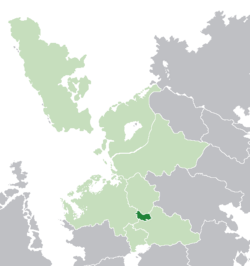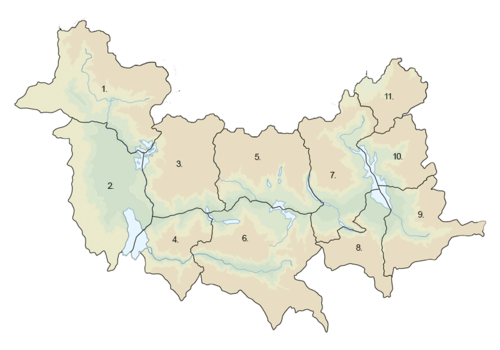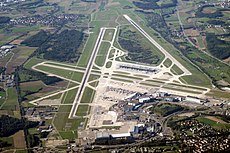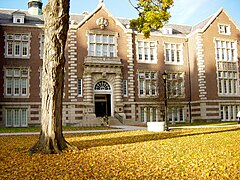Nidwalden
Grand Duchy of Nidwalden Großherzogtum Nidwalden (Nidwaldeser) | |
|---|---|
Motto: "Wir wollen bleiben, was wir sind" (Nidwaldeser) "We want to remain what we are" | |
Anthem: Unserer Heimatland (Nidwaldeser) "Our Homeland" | |
 Location of Nidwalden (dark green) – in Lorecia (green & dark grey) | |
| Capital | Cologne |
| Largest | Saint Moritz |
| Official languages | Nidwaldeser |
| Recognised regional languages | Noordenstaater and Scanonian a |
| Demonym(s) | Nidwaldeser |
| Government | Unitary parliamentary constitutional monarchy |
| Wilhelm II of Nidwalden | |
| Charlotte Mann | |
• Water (%) | 4.5 |
| Population | |
• 2019 estimate | 5,350,000 |
• 2017 census | 5,323,933 |
• Density | 202/km2 (523.2/sq mi) |
| GDP (PPP) | 2016 estimate |
• Total | $377.100 billion |
• Per capita | $66,578 |
| GDP (nominal) | 2016 estimate |
• Total | $391.959 billion |
• Per capita | $67,890 |
| Gini (2015) | 23.5 low |
| HDI (2015) | very high |
| Currency | Nidwaldeser Krone (NWK) |
| Driving side | right |
| Calling code | +77 |
| Internet TLD | .nw |
a Although not officially recognised, these languages are widely spoken and understood. | |
Nidwalden, officially the Grand Duchy of Nidwalden (Nidwaldeser: Großherzogtum Nidwalden) is a landlocked mountainous country located in Lorecia bordering Noordenstaat to the west, Fyngaria to the north and Scanonia to the south and east. Cologne is the seat of the Nidwaldester crown and Government, as well as a major financial centre for the country. The population is equally distributed in the complex mountainous territory of Nidwalden, the country has an area of 41,285 km2 that is home to 5,323,933 inhabitants, that in recent studies, 23.3% of whom declared a close foreign background from other Lorecian countries. The official language is German, however, the closeness and free movement with its neighbouring countries has made of Dutch, Scanonian and Albish widely understood languages.
Like in the surrounding countries, the past of the Nidwaldester people has a stretch relation with the Arlethic peoples and several Viking tribes from Scanonia, which coexisted and mixed with the Arlethi, developing what is known today as a unique Nidwaldester identity. Christianization took place in the 8th century with the arrival of the first missionaries from [] and lasted until the 12th century. Despite the small territory of Nidwalden, the conversion to Christianity is documented slow and nominally as the terrain difficulty requested additional efforts. Nidwalden was constituted by small Duchies and city-states when it joined the Nassau Union and around 1350 a unified Grand Duchy was formed existing without interruptions since then. After withdrawing from the Nassau Union, Nidwalden faced the Protestantisms with the foundation of the Church of Nidwalden during the 16th century. The first Constitution of Nidwalden was signed on 24 July 1718 turning Nidwalden into a parliamentary constitutional monarchy, founded in the sovereignty of the people, human rights, and separation of power.
After signing the constitution, Nidwalden ended being an absolute monarchy starting a new era of socially progressive changes that deepened the democratic culture of the Grand Duchy. During the 20th century, Nidwalden maintained a neutral position in the several conflicts of Astyria, in 1920 Prime Minister Helle Johansen signed the Sankt Moritz Agreement that set bases of the large Nidwaldester welfare state model with members of all the political parties of Nidwalden. During the first decades of the century, the population reached advanced social rights like civil marriage, divorce and the separation of the state from the church that created the bases to later accomplish the recognition of Same-sex unions in 1989, abortion in 1984 and Same-sex marriage in 2001.
The country is a founder member of the Lorecian Community, the Astyrian Peace Organization and the E10 Council of Nations, it is a member of the World Assembly since 1998. With a very developed and mixed economy, Nidwalden has a very large welfare state providing universal health care and tertiary education for its citizens. The Nidwaldester economy is based around the financial and banking sector, the pharmaceutics and the technology with large contributions of tourism and agriculture. The country ranks at or near the top globally in several metrics of national performance, including government transparency, civil liberties, quality of life, economic competitiveness, and human development.
History
Early 20th century (1900-1920)
Great Astyrian War and post-war prosperity (1920-1945)
Geography
Nidwalden has a total area of 41,285 km2, which makes it the smallest country of the Lorecian Community and one of the smallest in Lorecia. It is located in the centre of the Lorecian continent and borders Noordenstaat to the west, Fyngaria to the north and Scanonia to the south and east. The territory of Nidwalden is subdivided by the Environmental Research Institute of the Kiefern Group in three regions: the north that counts with the presence of the Silberberg Mountains bordering Fyngaria; the south that borders Scanonia with the [] mountains chain and the western high lands and forests bordering Noordenstaat. The first two regions are part of the [] Mountains chain that stretches across Lorecia and it covers most of the Nidwaldester area, altitudes can vary without exceeding 4,700 metres. There is no difference between Northern and southern mountains and their tallest points, in the north Zugspitze reaches 4,634 metres (15,203 ft) being the tallest point in Nidwalden, while in the south Matterhorn reaches 4,478 metres (14,692 ft). Mountains have an important place throughout the Nidwaldester history and are today one of the characteristics of the country.
The formation of high peaks has caused over the years, the formation of several lakes across Nidwalden. Most of these water bodies are found in the central valley (between northern and southern mountains), the western high lands and in the east. Two of the largest lakes are Brienz (which comprises the coast of the city of Vaduz and Zell am See) and Aare (coast of Saint Moritz).
Flora and fauna
Climate
Politics and Government
Administrative Divisions

|
| Canton | N° | Capital | |
|---|---|---|---|
| Rhine | 1 | Cologne | |
| Grevenmacher | 2 | Vaduz | |
| Vorarlberg | 3 | Feldkirch | |
| Wiltz | 4 | Zell am See | |
| Fribourg | 5 | Lech | |
| Bergig | 6 | Bremen | |
| Diekrich | 7 | Innsein | |
| Solothurn | 8 | Aspen | |
| Saanen | 9 | Erzberg | |
| Thurgau | 10 | Saint Moritz | |
| Schaffhausen | 11 | Glarus | |
Foreign relations
Military
The Nidwaldeser Army, Air Force and Home Guard compose the Nidwaldeser Armed Forces; these are under the command of the commander-in-chief, who is the Grand Duke of Nidwalden. Since 1904, military service is voluntary and as of 2018, the armed forces employed a total of 18,983 personnel, which include civilians. The commander-in-chief is the Grand Duke of Nidwalden and the four branches are subordinate to the Nidwaldeser Ministry of Defense. Decisions are usually taken in conjunction with the Grand Duke, the Prime Minister of Nidwalden, the Minister of Defense and the Minister of Foreign Relations, although the Grand Duke has the final word on the resolution.
The defence of the Grand Duchy also depends on the Nidwaldeser Intelligence Service, an intelligence agency whose responsibility is to protect the interests and infrastructure of Nidwalden as well as of the Lorecian Community, the agency is in charge of the Onyx network, an intelligence gathering system whose purpose is to monitor by intercepting both civil and military communications. Despite its difficult terrain, Nidwalden enjoys a large and intelligent military infrastructure developed to attack in case of invasions. The Air Force has a structure of seven air bases, two of them capable of handling only helicopters in case of emergency.
During the 1980s Nidwalden experienced a pacifist movement and the existence of popular anti-militarist groups which launched a referendum to cut gradually the activities of the armed forces and to abolish the armed forces altogether. Despite small defeats in both referendums celebrated, the population decided to maintain its armed forces.
Economy
The economy of Nidwalden is one of the most stable economies in Lorecia. The political stability and the long culture of human rights has given to Nidwalden millions of safe investors creating an independent, safe and huge economy. The country has a stable and high-income market economy features moderate growth, low inflation, and a high level of innovation, the unemployment rate has been traditionally low and it is actually positioned in 2.5% of the population. The country is one of the richest countries of the world with a nominal GDP per capita at $104,359.
The financial sector is one of the most traditional sectors of the Nidwaldester economy, banking and finance play a very important role in the economical scene of the country, like others countries in Astyria, Nidwalden plays a role, specially for the Lorecian Community, as a place of low taxes, political and economical stability and safety for saving great amounts of money. Saint Mortiz and its financial centre are known for being the core of many of the economic decisions taken in Nidwalden.

The service sector comprises the majority of the Nidwaldester GDP and in recent years the numbers saw an increment due to the enlargement of the information and technology sector. Nidwalden has positioned itself as one of the most technologized countries in the Lorecian Community, the city of Vaduz in the south of the country has the highest number of startups per person in Lorecia and has been named as one of the best cities of Astyria to start or move a technology focused enterprise.
The city Lech is one of the homes of the modern car in Astyria, the automotive industry comprises also an important part of the GDP as it is considered to be one of the most competitive and innovative of the world. However, since the 80s the Nidwaldester society has faced an important environmental conscience that has take it to produce more eco-friendly products in the industrial sector, changing the aluminium production for high-value-added, non-polluting industries, such as cosmetics and biothermics.
Energy and Infrastructure
The electricity generated in Nidwalden is fully produced by the state-owned company NidEnergie, in 2018 a 95% of the total of energy produced in Nidwalden was made by renewable energy methods such as hydroelectric power stations and wind parks, an specifically large number in the region. In past years, Nidwalden was unable to produce as much energy as it was needed and thus, forced to buy it from neighbouring nations with larger produces like Noordenstaat, however, since the 1970's, governments have undergone special investments with NidEnergie pursuing a total energetic independence from its Lorecian neighbours. The geographical situation of Nidwalden, with a vast network of lakes interconnected by rivers and high mountains, have given to the country an enormous advantage for the production of energy from renewable methods.
Nidwalden has one of the densest rail networks in Lorecia. The vast majority of the network is operated by the national company Nidwaldeser Bahn which has focused its business into improving the reliability and quality of service of its conventional rail network. The difficult terrain of Nidwalden and the short distances between cities and towns has been a challenge for the company in building high-speed networks, there are currently three major high-speed lines, Cologne-Saint Moritz, Cologne-Vaduz and Vaduz-Saint Moritz, the three of them are connected with Noordenstaat and Scanonia.
The mountainous country has five international airports, Cologne International Airport, Vaduz International Airport, Aspen International Airport, Lech Airport and Saint Moritz International Airport, the last one is the largest one and a major connection hub with the rest of the Lorecian Community and Astyria for the flag carrier airline, Air Nid, the Aspen International Airport operates international flights only during winter and has only ten destinations in total. However, most of the cities in Nidwalden count with facilities for airplanes.
Demographics
Estimations done in 2018 agreed that the population of Nidwalden was of 5,323,933 inhabitants. As the rest of the countries of Lorecia, Nidwalden increased its population together with the industrialization of the economy between 1800 and 1990, however, this growth has been slow and stable, estimations done by specialist of the World Assembly say that the Nidwaldester population will remain without exceeding the number of 5,400,000 until 2030. Immigration and an exceptional quality of life is what gives to the population of Nidwalden this character of stable.
As a developed country in Lorecia, Nidwalden counts with a vast community of foreigners, 23.3% of the population has recognised having a foreign background from his close past. Most of the immigration comes from neighbouring countries like Scanonia, Noordenstaat, Fyngaria or Albeinland thanks to the possibilities given by the free movement accords of the Lorecian Community. During the early 2000s several social institutions and political parties (mainly from left backgrounds) expressed its concerns for an increasing xenophobia in the Nidwaldester society and populist political campaigns, in reply to this, the Ducal government stated that ‘the situation of xenophobia was unacceptable in a country like Nidwalden’, in the following years actions were taken in schools and in the social scene to ensure rapid and unproblematic integration of foreigners.
Healthcare

The government of Nidwalden follows a system of insurances that every citizen should have. Legal citizens of Nidwalden and visitors have the right to a quality healthcare service that is given in an enormous network of hospitals and clinics funded by the state. Insurances are generally from private companies, once the applicant needs the service these are free (as it is paid with a mensual fee) and include emergency facilities, treatments and specialized medicine. While the cost of the system is among the highest, it compares well with other Lorecian countries in terms of health outcomes; patients have been reported as being, in general, highly satisfied with it and the state keeps a very high engagement of the population into insurance plans, an overwhelming 99% count with a life insurance that ensures quality healthcare at any moment.
Religion
Nidwalden has no official religion, church and state has been officially separated since 1917 and the religious freedom is guaranteed by the constitution since then. However, a survey done by the official agency of statics of the Grand Duchy showed that Protestantism remained as the main religion with a 57.9% of adherence in the population, it was followed by atheists and/or agnostics with a 40.7%. According to political observers, Nidwalden is one of the most secular countries of Astyria, for many, this process of secularization began during the protestant reformations of the churches where new ideas were spread along the country.
In 1885 civil marriage was recognised, and in 1887 the state took over the running of public cemeteries. In 1907 divorce was legalized and, in 1909 all religious instruction was banned from state school, much more time after the church reformation the innovative Prime Minister Ludwig Mann (1903–1911) completed the separation of the church from the state.
The protestant reform of the church and then the secularization process of Nidwalden is thought to be one of the reasons why the society of the small country has been very open and receptive to innovative laws and ideas. In modern times the population has supported the recognition of Same-sex unions in 1989 and the later Law that approved Same-sex marriage in 2001, years before, in 1984 Nidwalden was also one of the first countries to fully legalize the Abortion.
Largest cities
The population of Nidwalden has switched from a largely rural population to one mostly urbanised, its process of urbanisation happened during the second half of the nineteenth century and the first decades of the twentieth after a strong influence of industrialisation processes led by the first Ludwigist wave. Cities in Nidwalden and well marked by the different historical times and its designs; the geography of the nation has conditioned the use of the territory and cities and towns happen to be compacted in valleys, urban sprawl and suburbs are an almost nonexistent problem, however, medieval towns and old populations around fortifications and castles are a common phenomenon that has shaped many aspects of the Nidwaldester urban designs and local economies. Largest populations in cities have been historically concentrated among Cologne and Saint Moritz, however, recently other cities like Lech, Vaduz, Bremen and Innsein have experienced important population growths.
Largest cities or towns in Nidwalden
According to SAN | |||||||||
|---|---|---|---|---|---|---|---|---|---|
| Rank | Name | County | Pop. | ||||||
 Saint Moritz  Cologne |
1 | Saint Moritz | Graubünden | 746,878 |  Vaduz  Lech | ||||
| 2 | Cologne | Rhine | 255,464 | ||||||
| 3 | Vaduz | Grevenmacher | 246,697 | ||||||
| 4 | Lech | Vorarlberg | 222,125 | ||||||
| 5 | Bremen | Capellen | 117,510 | ||||||
| 6 | Innsein | Diekrich | 111,267 | ||||||
| 7 | Zell am See | Wiltz | 92,753 | ||||||
| 8 | Mégeve | Sallanches | 61,536 | ||||||
| 9 | Beret | Capellen | 52,163 | ||||||
| 10 | Kitzbuhel | Wiltz | 51,571 | ||||||
Education
Like the neighbouring countries of Noordenstaat and Scanonia, Nidwalden has a developed education in which students have a performance that overpass regional averages. The education system is the responsibility of the Ministry of Education in all the Nidwaldester territory. Optional Kindergarten is offered for all children between one and six years old, after it, primary and secondary school are compulsory and last six years each one, secondary school is divided between the first three years and then another three years, in the last two years children can choose an ‘orientation’ where the education imparted more specialized in different areas. All children graduated from secondary school are able to speak English on level B2 and a third optional language on level B1.
Nidwalden has a long tradition of higher education, most universities are public institutions and students can attend without fee payment. The country has one of the highest rates of student enrolment in Universities, this contributes to having a very specialized workforce. Nidwalden is home of the Kiefern Group, a group of the best five public universities, the name of the group is often synonymous of academic excellence.
- Universities of the Kiefern Group
Culture
Nidwalden shares many strong cultural and historical ties with the neighbouring countries of Scanonia and Noordenstaat. The country has been historically one of the most progressive cultures of the world, Nidwalden was one of the first countries in Astyria and the world to allow same-sex unions in 1989, abortion in 1984 and legal same-sex marriage in 2001. Modesty and social equality are important parts of a culture that has been shaped through history by major intellectuals, artist and new thinkers that later became important for the new waves of think in Astyria.
Architecture and design
Nidwaldester design and architecture has grown while being characterized by the simplicity, minimalism and functionality, it is a style worldwide famous. Initially influenced by the Bauhaus school, Nidwaldester designers and architects took different ways to persuade a different style, however, the culture for design in Nidwalden dates from long before the 20th century, despite the small size of the country, different areas developed different styles, this contributed to a major diversity in architectural styles. The most typical constructions along the central valley date from the Middle Ages and follow Romanesque styles. Gothic architecture flourished during the high and late medieval period and with this large Gothic influence, castles started to be constructed appearing through the whole country and being today the most distinctive architectural pieces of Nidwalden, most of them are located in the cores or up in hills near towns, where half-timbered buildings became part of the Nidwaldester culture.
The progressive industrialization and the years of stable growth helped to develop a more modern side of the architecture in Nidwalden, large cities like Saint Moritz, Cologne and Lech are known for its modern buildings of distinctive Nidwaldester Design. The Mégeve County Councils and the Bremen City Hall, the Kirchberg borough of Cologne, the skyscrapers of Saint Moritz and many of the contemporary developments in the cities of Vaduz and Lech are just some of the most recognised pieces of modern Nidwaldester design.



















